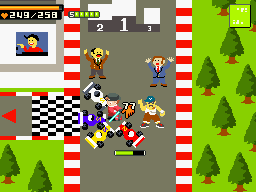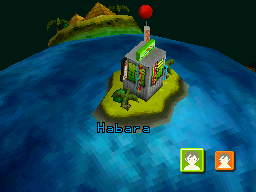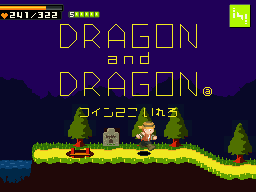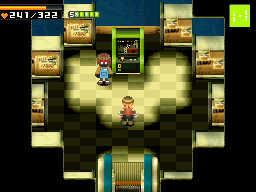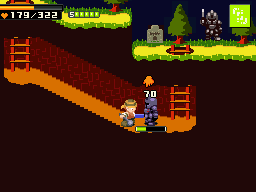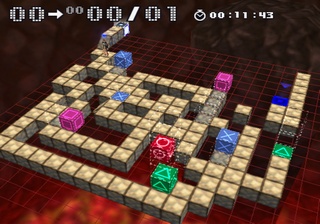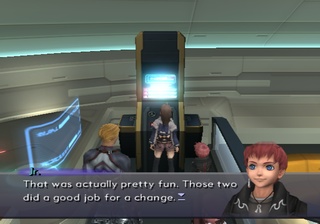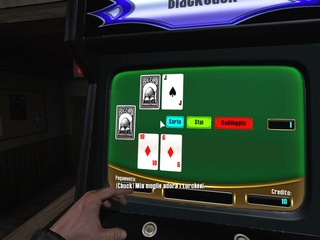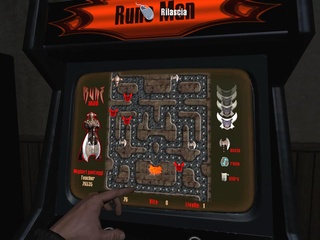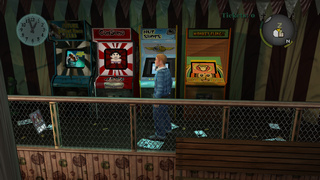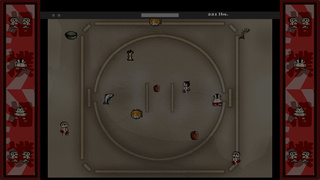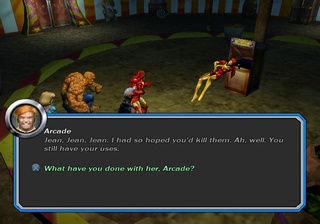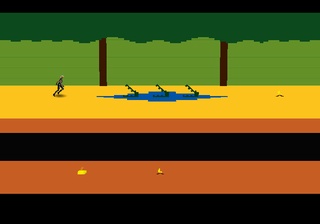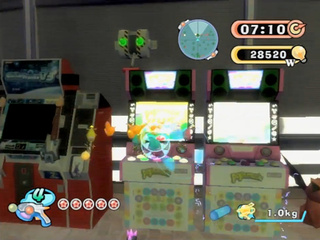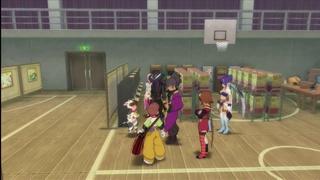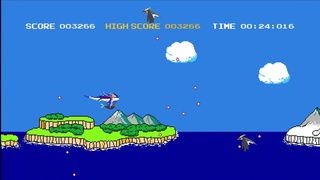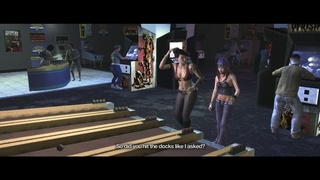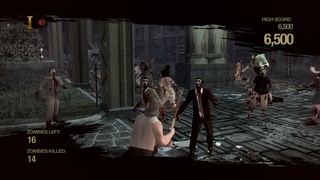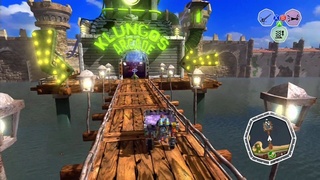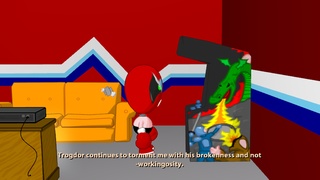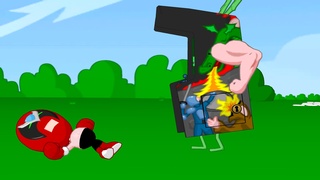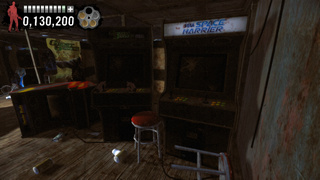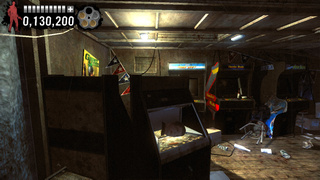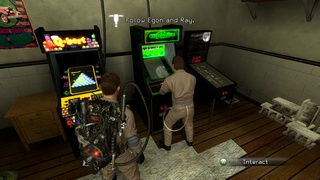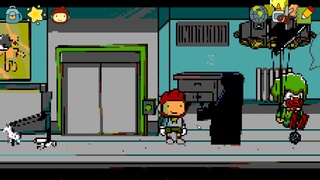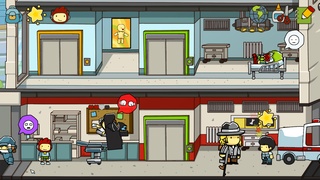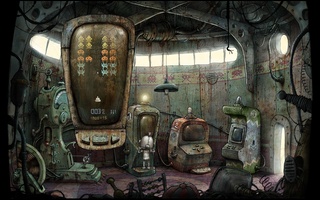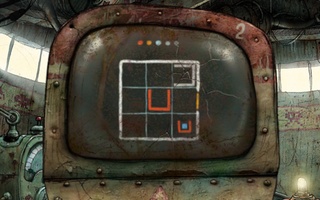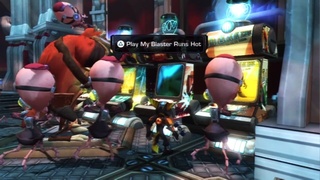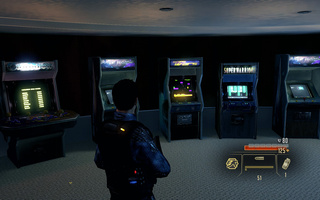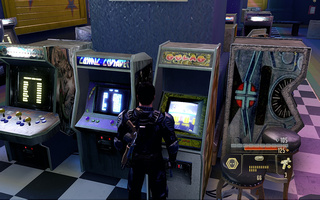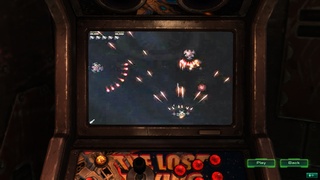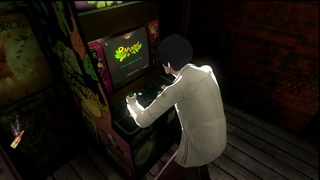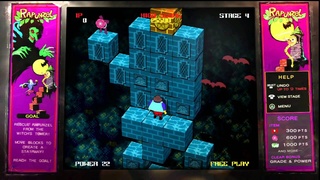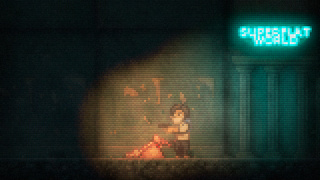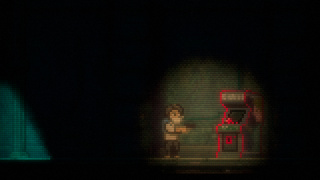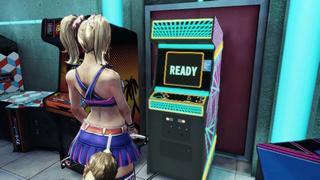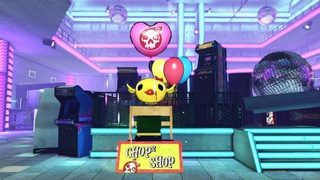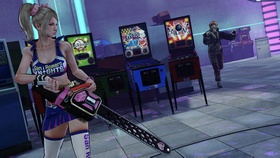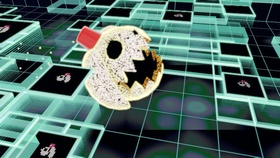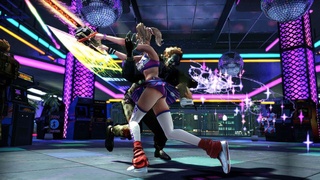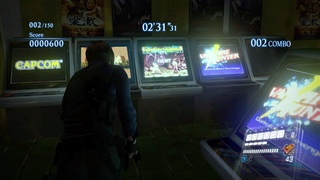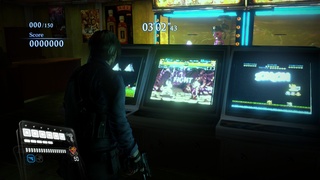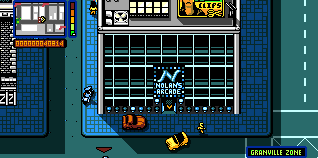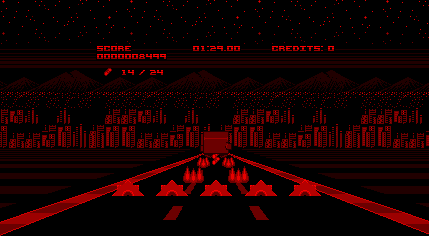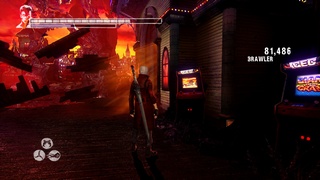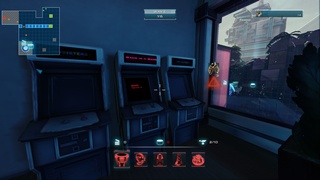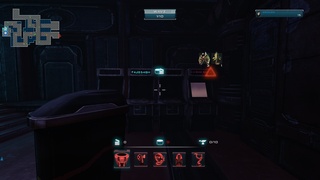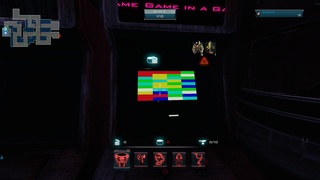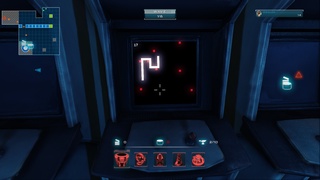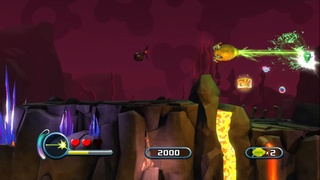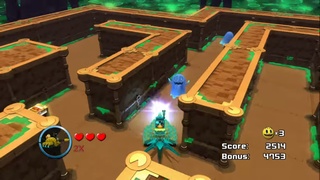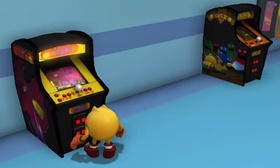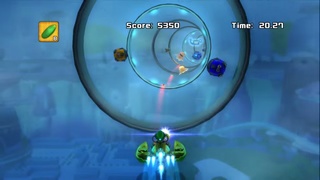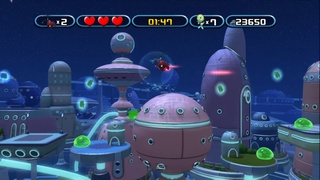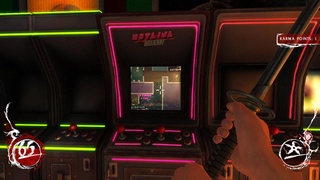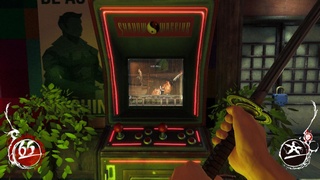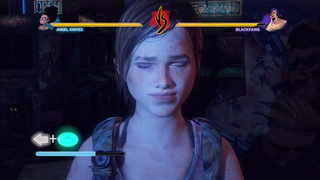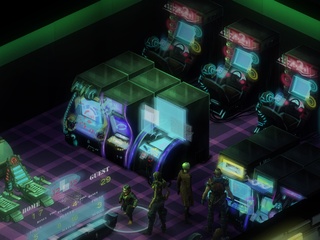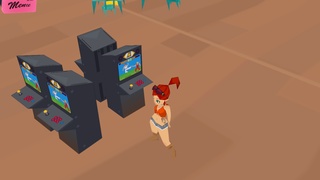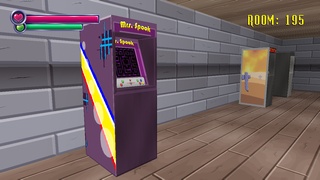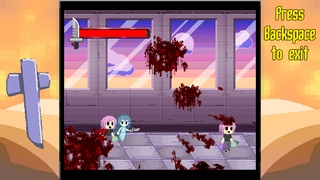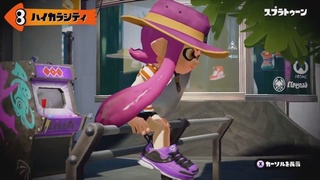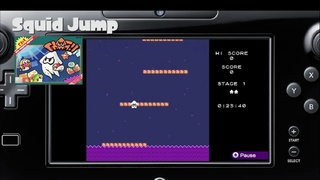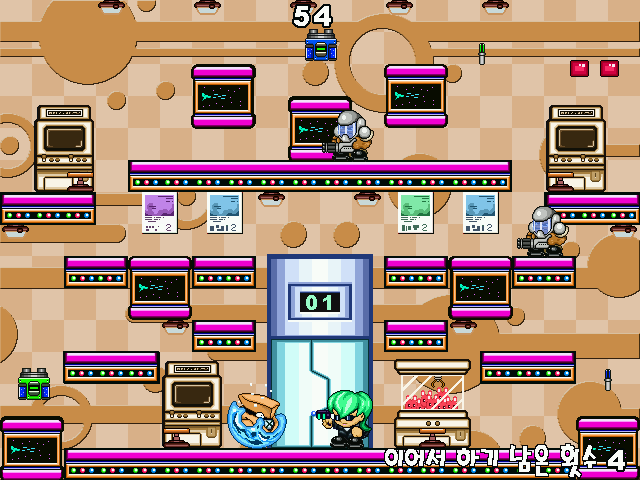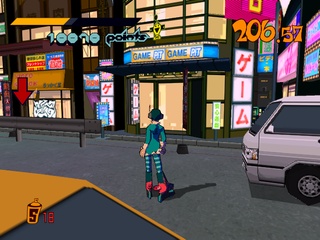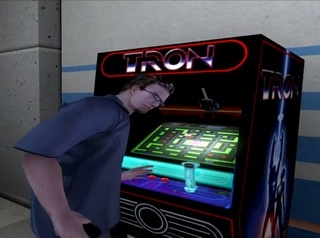
Inventories: Arcades in Video Games
Contact (2006)
Contact (NDS)
Contact styles itself as kind of a parody on JRPGs, with ludicrous bezel stickers that give you power and a character in the game frequently addressing the player directly, over the head of the protagonist. One of its areas is Habara, a play on Tokyo's famous nerd Mecca Akihabara. Here, the hero happens upon two arcade machines, which he must enter to get through their 8-bit worlds. The first is a racing game named "BTM 2005", where he wins not by getting to the goal ahead of everyone else, but by smashing all the cars in the race. Next is Dragon and Dragon an RPG-ish arcade action game like Tower of Druaga or Dragon Buster, complete with overhead and sidescrolling segments.
Contact (NDS)
Xenosaga Episode III (2006)
"Hakox" in Xenosaga Episode III can be accessed from multiple locations. One looks more like a computer terminal, but the one in the Elsa cantina is definitely an arcade cabinet. "Hakox" is a fully realized 3D puzzle game with so many levels it could almost have been sold as a standalone title. That's probably why the developers didn't want their work go to waste and actually force you to play the game to progress the story. You don't need to achieve anything, though - just start up the game and then quit eventually.
Prey (2006)
Prey was built on the same technology as Doom 3, but it even goes one step further. The game starts out in a bar area, which is full of actable entertainment screens, from TVs to arcade machines. Most of them are just boring card games or digital slot machines, but you can also try your hands at the Pac-man like Rune Man, which borrows the aesthetics of Human Head Studios' earlier Viking hack-n-slash game Rune.
(images taken from FpsTeam.it)
Bully (2006)
Since Bully is essentially Rockstar Games' teenage version of Grand Theft Auto plus a ton of mini games, it inherits San Andreas' affinity for playable arcade cabinets. One game is right in juvenile delinquent Jimmy Hopkin's dorm, but there are more locations to find other games. The prize shop at the carnival, which becomes available in chapter 2, almost qualifies as a proper game center, as it has all five machines in the game.
Many of the games are cheap-looking retro knock offs like in San Andreas. Nomen est omen in "Monkey Fling!!", and so you play as a monkey to fling poo at spiders in a Space Invaders setup while trying to catch bananas that allow you to produce more poo. "Nut Shots" is a horizontally scrolling shooter starring a flying squirrel. The most innovative of this bunch is "ConSumo", where you walk around an arena as a tiny sumo wrestler, who has to catch food that flies across the screen while avoiding bad food, pushy sumo opponents and deadly globefish. The interesting part is that the game increases the difficulty each level by making the sumo wrestler grow bigger.
The main attraction is the top-down racing game "Future Street Racer 2165", which actually has astonishingly high production values, running in a 3D engine. It also has a sequel in a cockpit cabinet called "Future Street Racer 3D", which is exacly the same except for the perspective, which is switched for an over-the-shoulder camera. Both variants are quite rad for tiny optional distractions.
Marvel: Ultimate Alliance (2006)
Marvel Comics have a minor but popular villain who's actually named Arcade, so the big Ultimate Marvel mashup brawler should be predestined for this list, no? Actually, Arcade is just a murderous carny for the most part, running a circus full of evil clowns, but that doesn't mean that he cannot mind control Jean Grey and suck her into a Pitfall! cabinet (once again ignoring the fact that it was only released on home systems in the real world) as she fails to kill the team of heroes. The selected superhero then goes after her, and finds herself in the two-dimensional world of the game. The current 3D model is still used instead of the Pitfall Harry character sprite, though, so the physics feel more than a little bit off. The game still has almost all of the features of the original game, including the gold bars, even though they don't do anything as there is no score and you can try as many times as you need. Contrary to the 1982 version, it also has a very limited number of screens. At the end you find Arcade's devilish machine, and destroying it frees both characters from the cabinet.
Elebits (2006)
Akihiro Ishihara's frantic hunt for little critters features a kind of amusement park with mission 26, which has a few Bemani cabinets in a corner: Guitar Freaks V3, Beatmania IIDX and Pop'n Music, with animated gameplay screens as you switch them on. Like almost any object in that game, you can (and have to) fling them around with your beam to reveal the Elebits hiding behind, under or inside of them.
(images taken from Michael Ashworth's Lets Play on Youtube)
Tales of Vesperia (2008)
The repurposed gym area in this game has a row of arcade cabinets, which allow you to play "Tales of Draspi", a horizontally scrolling shoot-em-up whose title screen is ripped from the old Namco shooter Dragon Spirit.
(images taken from Ramza411sb's Let's Play on Youtube)
Saints Row 2 (2008)
Several bars and night clubs in Saints Row 2 feature an arcade machine called Zombie Uprising, but there's also a dedicated arcade visited in the course of a mission for the Saints. It has ball games, pinball machines and various nondescript video game cabinets, alongside the big title. Other than the arcade games in Grand Theft Auto games, Zombie Uprising is not some mockup '80s style game, but uses the same engine as the main game, only with some annoying filters. In the game, you run around killing zombies, protecting victims and avoid getting eaten. The game also becomes available on a console in the player's cribs. A cabinet for the sequel Zombie Uprising 2 can be found in Saints Row IV, alongside a machine titled Saints Row 3, but they appear to be out of order.
Banjo-Kazooie: Nuts & Bolts (2008)
Former henchman Klungo has settled down and opened up shop in Klungo's Arcade. You never actually get to set foot inside the extravagant establishment, but you can talk to Klungo at the entrance and he lets you play "Hero Klungo Sssavesss Teh World", an automatic runner platform game with Klungo as the self-insert hero who literally carries around a globe to safety. Klungo isn't much of a programmer though, so the game is pretty bad and tends to crash a lot. Much more impressive is the retro sci-fi style cabinet art. Later, the sequel "Hero Klungo Sssavesss Teh Universsse" became available via DLC.
(images taken from Z Gaming's Let's Play on Youtube)
Strong Bad's Cool Game for Attractive People (2008)
Strong Bad has an arcade cabinet of Trogdor, which was an earlier Homestar Runner flash game from 2003 starring the titular dragon as he wreaks havoc on medieval villages. Throughout most of the game it just stands there broken, but in the final episode it grows Trogdor's legs, wings and starts causing a ruckus. Strong Bad of course has to deal with it, if only so he can play the game again.
The House/Typing of the Dead Overkill (2009/2013)
The tongue-in-cheek grindhouse style spin-off of Sega's popular lightgun shooter / typing tutor series features a level called Carny, which is exactly what it says. On their predefined course, the players also go through an old trailer that used to function as a run-down arcade before the zombies ran over everything. It is filled with Sega classics such as Space Harrier, Power Drift, Thunder Blade and Zaxxon, but also Ghost Squad, even though Overkill is supposed to take place in the 1990s. In this case, it's not so bad that they machines are not switched on - who would want to play a game where dead severed hands are still clutching the joysticks? There are also three minigames that are presented as arcade machines in the menu.
Ghostbusters: The Video Game (2009)
The Ghostbusters have always been playful types. There are arcade machines in their repurposed firehouse even in the movie, but you never get a good look at them. This changes in Terminal Reality's sequel in video game form, where you can freely walk around the HQ in between missions. Tucked in a corner is a faithful recreation of the Q*bert cabinet (owned by Columbia, just like Ghostbusters), next to a shooter called "Monstrosity X" and the pinball table "Strangeness". Sometimes you see the Ghosbusters playing the games, and you can "interact" with the machines as the new recruit, but that only results in him standing in front of the machine pretending to be playing for a while.
Scribblenauts series (2009-2012)
Scribblenauts is all about making things appear or transform by scribbling words in a notebook. Naturally, you can also scribble in as many arcade and pinball machines as you like. The pinball machine only makes some music, but when you "play" the arcade machine, the entire game switches to a pixellated low resolution. You can also give it wings, make it eat humans and fight against the mafia, because this is Scribblenauts.
In Super Scribblenauts for the NDS, interacting with the arcade machine leads to a tiny mini game where you click on rockets on the touch screen before they blast a wall of blocks at the bottom of the screen.
Machinarium (2009)
Machinarium is filled with mini games that often reference classic video gaming, like the little LCD type display where a key needs to be maneuvered past scrolling obstacles to open the in-game walkthrough. There is also an arcade game room where the little robot hero can ride a bicycle to power up a variety of machines. The first one is a playable Space Invaders clone on a very narrow display. Machine number 2 is a clever little puzzle game where you move boxes by stepping into them from their opened side. The third and final machine unfortunately breaks down as soon as you switch it on.
Ratchet & Clank Future: A Crack In Time (2009)
The one free cabinet in the small arcade corner in Ratchet & Clank Future: A Crack In Time runs "My Blaster Runs Hot", a take on the Robotron 2084/Smash TV formula, where you shoot incoming waves of enemies with a two-stick control scheme while rescuing green alien ladies.
(images taken from DerfsonicGaming's video on Youtube)
Silent Hill: Shattered Memories (2010)
The rather loose 2010 remake of Silent Hill unfortunately does not preserve any of the awesome Kindergarten Cop textures of the original, but at least it replaces them with '80s Konami arcade goodness in the entrance hall of a movie theatre in the mall. They're all broken with their screens smashed in, but when Harry Mason takes a closer look at them, he remarks: "Huh, some real classics!"
Alpha Protocol (2010)
In the course of your fight against a conspiring arms manufacturing conglomerate in Obsidian Entertainment's innovative espionage action RPG, you take on a Russian crime boss and infiltrate his yacht. And what does every self-respecting Russian crime boss need on his yacht, besides hookers, booze and cocaine? Exactly, his own swimming video game arcade. All the machines have 8-bit style game mockups on their displays, but unfortunately none of them is playable. Then again, we're not sure if we would want to play a game titled "Gulag"...
(images by AshTR and Pugglevania Bloodlines taken from the Steam Community)
Starcraft II: Wings of Liberty (2010)
The cantina in the campaign mode of Starcraft II's Terran edition features a lone arcade cabinet called "The Lost Viking". Despite the title, this has nothing to do with Blizzard's own puzzle platformer The Lost Vikings, but is a vertical shoot-em-up built with the Starcraft II map editor. The title screen teases a pixel art style, but the game graphics are all polygonal.
(images by taken from PC Games)
Catherine (2011)
At this point, this list probably has more single arcade machines in locations they're peripheral to rather than dedicated game centers, and Catherine adds yet one more. In the Stray Sheep bar, protagonist Vincent Brooks finds a game called "Rapunzel", which is suspiciously similar to his nightmares that form the main game, only limited by turns instead of time. The cabinet art is especially lovely designed in period-appropriate style, and even shows a bit of wear to make it look more natural.
(images taken from TheMusicalGamer11's Lets Play on Youtube)
Lone Survivor (2012)
The last chapter in Jasper Byrne's 2D survival horror tale leads through a dark, uninviting arcade called Superflat Games - which incidentally is also the name for Jasper Byrne's studio. All the games inside are based on other games by Jasper Byrne (and one fourth wall-breaking cabinet titled "LS"). While you cannot play them, you can at least make the protagonist comment a bit on them.
Lollipop Chainsaw (2012)
Lollipop Chainsaw
In Lollipop Chainsaw's arcade area, there are a lot of machines with more or less generic titles, but pretty nice cabinet art which allude to real world classics. By some of them, Juliet gets transported into vaguely Tron-like game worlds, where she has to beat several mini games to break free.
Lollipop Chainsaw
Resident Evil 6 (2012)
This arcade is not found in any of the main story campaigns of Resident Evil 6, but the map Urban Chaos in Mercenaries mode. Players can walk through it and admire non-interactive screens of many Capcom classics, including Vampire Hunter, Star Gladiator, Commando, Ghosts 'n Goblins and Son Son. Who doesn't remember Son Son? Oddly, the walls of the joint are plastered with posters for movies and drinks instead of more video game references.
(images by "€S C 90 darksonic872" and Mr Dave taken from the Steam Community)
Retro City Rampage (2012)
Retro City Rampage is chock full of references to classic video games, but the machines you can find in Nolan's Arcade - if you can find it in the huge city - are not just some throwaway puns like you see all around the billboards outside, they're actual playable games, based on a few other famous indie titles.
Retro City Rampage (Windows)
Bit.Trip Runner's simple gameplay ideally lends itself to being a mini game, so it is pretty much the same concept as the full game, only shorter and in genuine 8-bit demake style. "Virtual Meat Boy" deviates much further from its reference for a three-dimensional Virtual Boy homage that plays like the Konami MSX classic Antarctic Adventure. "EpicMealTime" isn't based on a game at all, but the popular Youtube show about cooking really unhealthy food. Nothing like the official show tie-in on smart phones, it mimicks fighting game bonus rounds where you just mash a button to fill a meter in a limited time. Finally, you can play a prototype version of the main game itself called "Rom City Rampage".
Retro City Rampage (Windows)
DMC: Devil May Cry (2013)
One of the objects that fly by naked Dante in the intro to Ninja Theory's unloved Devil May Cry prequel/reimagining is an arcade machine creatively labeled "Game". Throughout the game, there are a few more arcade cabinets found in the levels. One of them is called "Giant Enemy Crab", short GEC, but some of the screens actually show a scene from Street Fighter II. The other is called "Silverfish" and seems to be a 2D shoot-em-up. Neither of the games can be played, but the cabinets can be distorted by corruptions, making for some funny-looking results.
(images by Secondcourier, Mike and Zeema taken from the Steam Community)
Sanctum 2 (2013)
Sanctum 2 is a tower defense FPS hybrid, but it includes several other games that can be played on computer screens throughout the campaign. Two of these are presented as arcade cabinets at different locations. Both machines are labeled "Game in a Game", but when you start them the first is revealed as a variant of the old Snake game known from the old Nokia mobile phones, aptly titled "Snake!", while the other is a Breakout clone called "Take Out". Playing both of these games is awarded with an achievement.
(images taken by Dedlok taken from the Steam community)
Pac-Man and the Ghostly Adventures (2013)
Pac-Man returns with yet more arcade machine appearances. Unlike the Pac-Man World series, in the recent Pac-Man and the Ghostly Adventures (known as Pac-World in Japan), they are not made to relive the ancient original game. The game takes the yellow muncher to a Jetsons style future with lots of spheric architecture where apparently all the old Pac-Man arcade cabinets have been thrown out, so they feature four entirely new mini games based on fruit themes, which Pac-Man has to gather to access them.
Pac-Man and the Ghostly Adventures (Windows)
Lemon Blaster is a sidescrolling shoot-em-up, a low-stress alternative to games like Gradius. Tanks a Lot (for which you have to get pineapples because you steer a pineapple tank) sends you into a maze viewed from a third-person perspective, where you have to find and blast waves of ghosts. Cherry Copter Rescue is a variant on the arcade classic Defender, and Pacerchini Panic resembles the round tunnel races from F-Zero X, but is more about shooting obstacles out of the way than actual racing.
(images taken from packattack04082 and ZonicTHedgehog's videos on Youtube)
Shadow Warrior (2013)
Flying Wild Hog's remake of the old, racially insensitive 3D Realms shooter features quite a lot of arcade machines in it, but most of them are shut off. The few that actually run show Hotline Miami, Serious Sam, Hard Reset and the original Shadow Warrior - all games that really exist, like Shadow Warrior published by Devolver Digital, but none of them was actually for arcades. The games cannot be played, but you can throw in money to hear music from the respective game.
(images taken from TheGameGuru.Me)
The Last of Us: Left Behind (2014)
In this side story to The Last of Us, Ellie gets to connect with Riley, her best friend from her former school before the events of the main game. Together, the two manage to get power to the abandoned Raja's Arcade, with titles such as "Triple Phoenix" (with awesome side art of three TNMT cash-in style anthropomorphic birds), "Gobble Boy" or "Baboon Wrench Jeffrey". But the game that has the two girls' attention is "The Turning", presumedly an hyperviolent fighting game a la Mortal Kombat. Unfortunately, though, it is busted like all the other machines. No problem, says Riley, just close your eyes and imagine playing the game! What ensues is one of the most laughable uses of Quick Time Events in a game ever. In a corner Ellie can also find a broken deluxe cockpit cabinet of Naughty Dog's own Jak X: Combat Racing (only released on PlayStation 2 in the real world), where she can sit down and pretend to play once more.
(image to the right taken from NiZZULiVE on Youtube)
Shadowrun: Dragonfall (2014) and Shadowrun: Hong Kong (2015)
In your quest to save Berlin from impending destruction, you end up seeking out a mythical decker who supposedly has turned herself into a purely virtual being. So where do you meet her, in the Matrix? No, you go through hidden passages in the subway to enter a forgotten room full of decomissioned terminals, pinball tables and even a demolished phone booth. In the center stands an archaic arcade game machine, which is your key to your audience with your would-be informant. The next Shadowrun installment set in Hong Kong features an entire area of "vintage" arcade machines, next to an e-sports setup with the typical mind plug-in devices of the Shadowrun era. Once again none of the games can be interacted with. Talking to a NPC gamer that's hanging around there reveals a mention of the title "Tank Battle Europa", but there aren't any readable labels on the machines.
Catmouth Island (2014)
The arcade in this goofy indie adventure has a lot of games, including a Street Fighter parody (the heroine's comment: "I just push buttons and waggle the joystick."), a few pixellated shooters and the self-deprecating "Indie Shit".
Spooky's House of Jumpscares (2015)
Spooky's House of Jumpscares is a rather tedious arrangement of random rooms where not a lot is happening - at least for the first 200 of 1000 rooms. However, it's a free game so there's not much to complain. One of the rare highlights is the arcade that can be found randomly, just as the other rooms. While the interior decoration is just as spartan as the rest of the game, there are two playable machines - a Pac-Man clone with terrible mouse controls called "Mrs. Spook", and the sidescroller "Mall of the Spook" where you play as the ghost and rush with a knife through passengers, whom you have to slaughter to avoid running out of blood.
Splatoon (2015)
Nintendo's multiplayer paint shooter is going to feature arcade machines in its central hub area. These can be used to access up to four mini games starring a squid, which are oddly styled like early Famicom games, even including mockup box art. Unfortunately, it has been announced that three of the games will be locked behind arbitrary Amiibo scans. So given Nintendo's track record of distributing those, not everyone might end up being able to access the games.
Odds and ends
There are a few more games that didn't make the list as standalone entries, for a lack of enough content to show or talk about and couldn't be grouped into any fitting themes:
- The header image for this article is from Darius, which has a joke ending where you see the pilot of Darius playing Darius.
- The 1987 Japanese porn adventure Dreamy Town Majo features an arcade location, where you can insert a 100 yen coin and a woman on screen asks you if you want to play mahjong (you can't).
- Vital Light for the Amiga fashions itself as "the best arcade game ever invented", showing its own imaginary cabinet in the intro.
- Jet Set Radio's Benten area has a building called "Game Pit", which could be either an arcade or a games shop.
- The second stage in the controversial Korean Snow Bros. clone Terror-beom Bin Laden Jabara ("Catch the Terrorist Bin Laden") is an arcade with cabinets, UFO catchers and shoot-em-up displays in the background.
- The Korean raising simulation visual novel Strawberry Note 2 has an arcade area as well.
- In the intro to Tron 2.0, the hero Jet is seen playing the tank level of the original Tron arcade game.
Darius (Arcade)

